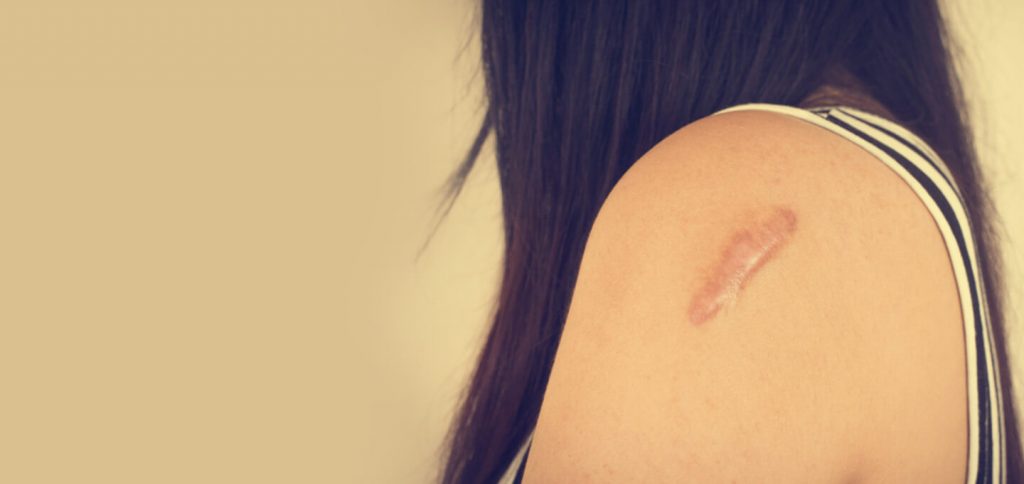Keloid scars can be difficult to live with. Unlike typical scars that fade over time, keloids continue to grow and spread beyond the original injury. They may become raised, itchy, and noticeable long after the skin has healed.
Left untreated, keloids can remain active and increase in size, causing both physical discomfort and cosmetic concerns. They may catch on clothing, remain tender to touch, or create self-consciousness in daily interactions. Trying over-the-counter products without professional guidance often leads to little improvement, while the scar continues to expand.
Fortunately, proven treatment options exist that can calm the scar, flatten raised tissue, and prevent further growth. At NW Face & Body, specialists evaluate each keloid carefully to provide a customized plan that delivers long-term control.
What Is A Keloid?
A keloid is a type of scar caused by excessive collagen production during the healing process. Unlike hypertrophic scars, which stay within the boundary of the original wound, keloids extend beyond it. They may develop after acne, piercings, surgical incisions, or even minor injuries.
Common signs include:
- A raised, firm scar that feels rubbery
- A pink, red, or darker color than the surrounding skin
- Itchiness, irritation, or sensitivity
Because keloids often continue to grow, early treatment is key to stopping progression.
Steps To Prevent Keloids From Worsening
1) Silicone products
Silicone gels or sheets are commonly used to reduce redness, flatten raised areas, and help control itching. They are often recommended as a first-line therapy.
2) Sun protection
Excessive sun exposure can make keloids appear darker and more visible. Protecting the scar with SPF or clothing helps reduce discoloration and irritation.
3) Avoid friction and irritation
Keloids that are constantly rubbed by clothing, jewelry, or straps may become more inflamed. Keeping the area protected and comfortable can slow growth.
4) Seek professional care early
Since keloids rarely improve without medical treatment, consulting a specialist before they become larger offers the best chance of long-term results.
When To Seek Treatment for a Keloid
While it is essential to work with us at the earliest stage possible to ensure the best healing outcome, it is also worth noting that a wound needs time to heal before scar treatment options can be evaluated. A fresh scar can look worse than it is and may heal sufficiently on its own with standard topical treatments.
Once the initial healing phase is complete, if a scar is causing discomfort, functional issues (such as difficulty bending a joint), or is cosmetically bothersome, it may be time to look into more advanced treatment options.
Professional Treatments That Control Keloid Growth
At NW Face & Body, a variety of treatments are available to shrink keloids, relieve symptoms, and prevent recurrence:
Steroid injections
Intralesional corticosteroid injections are often the first step. They help soften and flatten keloids by calming inflammation and slowing collagen buildup.
Cryotherapy
Freezing the scar can shrink smaller keloids and is sometimes combined with injections for better outcomes.
Laser therapy
Laser treatments may improve scar texture and reduce redness, making the keloid less noticeable.
Surgical excision
In select cases, keloids can be surgically removed. Because removal alone carries a high risk of recurrence, NW Face & Body combines surgery with preventive therapies such as steroid injections or silicone treatments to improve success rates.
Other adjunct treatments
Depending on the scar, additional therapies may be used to enhance results and minimize regrowth.
Everyday Habits That Help Manage Keloids
While in-office treatments are often necessary to stop keloids from growing, daily habits play an important role in supporting long-term results. Simple lifestyle adjustments can help reduce irritation, keep scars from worsening, and make professional treatments more effective.
- Wear soft fabrics that do not rub against the scar.
Avoid unnecessary skin trauma, such as piercing, if prone to keloids. - Keep skin moisturized and protected.
- Follow the specialist’s treatment plan consistently, even after initial improvement.
The Bottom Line
Keloids are stubborn, but they can be managed with the proper care. Silicone therapy, sun protection, and avoiding friction provide a solid foundation. In-office treatments such as steroid injections, cryotherapy, laser therapy, and carefully planned surgical removal can flatten existing scars and stop further growth.
Ready to take control of keloid scars? Schedule a keloid scar consultation in Kirkland with NW Face & Body to learn about customized keloid scar treatment options. With expert evaluation and a tailored plan, it is possible to improve appearance and prevent recurrence.
Frequently Asked Questions About Keloid Scars
What causes keloids to keep growing?
Keloids result from an overproduction of collagen during healing. This process continues even after the original wound has closed, which is why they can keep expanding.
Can keloids go away on their own?
Keloids rarely shrink or disappear without treatment. They typically require medical intervention to flatten or prevent further growth.
Are keloids dangerous?
Keloids are benign and not harmful to overall health, but they can cause discomfort, itching, and cosmetic concerns that affect quality of life.
What treatment works best for keloids?
The best treatment depends on the size, location, and severity of the scar. Steroid injections, cryotherapy, laser therapy, and surgical removal with preventive care are the most effective options offered at NW Face & Body.
Can new piercings or tattoos trigger keloids?
Yes. If there is a personal or family history of keloids, avoiding unnecessary piercings or tattoos is often recommended.
Additional Reads:





